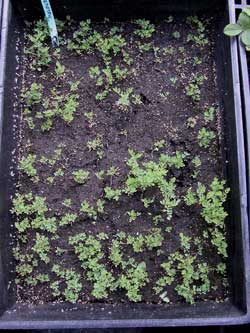Contributing to the Recovery of Leafy Prairie-Clover in Northeastern Illinois by Growing Plants from Seed and Planting in Restored Dolomite Prairie Habitat
 Leafy prairie-clover (Dalea foliosa.). Photo by Bill Glass.
Leafy prairie-clover (Dalea foliosa.). Photo by Bill Glass.
 Leafy prairie-clover seedlings. Photo by USDA Forest Service.
Leafy prairie-clover seedlings. Photo by USDA Forest Service.
Leafy Prairie-clover (Dalea foliosa) is a Federal Endangered plant species restricted to three separate regions of the eastern United States: central Tennessee, north-central Alabama, and northeastern Illinois. A perennial forb, leafy prairie-clover occurs only in open habitats with thin, calcareous soils. In Tennessee and Alabama, the preferred habitat is limestone or dolomite glades, but in Illinois, this plant is restricted to a very rare plant community, dolomite prairie. Although these habitats are usually not lost to traditional row crop agriculture because of the rocky and untillable soil, glades and dolomite prairies are being converted to industrial, commercial, and residential uses. Lack of management has allowed the remaining habitat to be lost to woody encroachment and non-native, invasive plants, including teasel, buckthorn, and bluegrass. Other contributing factors in this species decline are rock quarrying and over-collecting.
There are seven surviving populations of leafy prairie-clover in northeastern Illinois, including one on Midewin National Tallgrass Prairie. The populations range in size from a few hundred to several thousand individuals. Not all of these populations are protected, however, and records indicate that several additional, historically known populations have been extirpated. All these sites are or were once dolomite prairies.
Not all dolomite prairie remnants in Illinois still support leafy prairie-clover. These areas are suitable and some supported leafy prairie-clover in the past. There are opportunities to restore dolomite prairie at several locations in northeastern Illinois, including Midewin National Tallgrass Prairie. There are over one thousand acres that were once dolomite prairie on Midewin and other public lands; much of the land is available for restoration to its original condition. Some of this land, once restored, has the potential to support leafy prairie-clover. However, restoration of this species presents challenges, in part because small population sizes and past bottlenecks have contributed to reduced genetic diversity. Although it is relatively easy to grow from seed, leafy prairie-clover is difficult to establish in restored habitat. Most previous attempts at establishing new populations have not been especially successful.
Midewin National Tallgrass Prairie has facilities for propagating and handling native plants and their seeds as part of its ecological restoration program. The staff has considerable experience propagating a wide range of native plant materials and establishing these plants in restored habitats. In partnership with the U.S. Fish and Wildlife Service (Chicago Field Office), the U.S. Forest Service is now propagating leafy prairie-clover for out planting on restored dolomite prairies managed by the Forest Preserve District of Will County, the Department of the Army (Joliet Training Area), Illinois Department of Natural Resources, the Forest Preserve District of Kane County, and Midewin National Tallgrass Prairie. Seed has been gathered from all seven surviving local populations. These sources will be used to contribute to the new populations, resulting in large, restored populations with greater genetic diversity than the sources. At least six potential sites for out planting leafy prairie-clover have been identified. Plants not used in these out plantings will be used in a seed increase program at Midewin. Seeds from these plants will also be made available to partners for future out plantings and enhancement of existing populations. These new populations will contribute to the recovery of leafy prairie-clover in northeastern Illinois.
Project Partners
- USDA Forest Service, Midewin National Tallgrass Prairie.
- U.S. Fish and Wildlife Service (Chicago Field Office)
- Department of the Army (Joliet Training Area)
- Illinois Department of Natural Resources
- Forest Preserve District of Kane County
- Forest Preserve District of Will County

